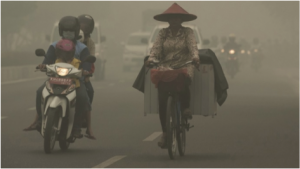Written by Anis Adrina Md Nor
The year 2015 has witnessed the worst transboundary haze phenomena in Southeast Asia and Malaysia. It was believed to be started since July 2015 and lasted until near end of November 2015. The worst was during October as the month witnessed the peak of the forest fires which were uncontrollable in Riau province in East Sumatra, South Sumatra, and parts of Kalimantan on Indonesian Borneo.

Photo source: Al Jazeera.com
This case had been reported widely by every local news media as well as international media as it has raised the health issue and public interest. Hence, this article would compare the reporting of the haze issue in Southeast Asia and Malaysia by one Malaysia local news agency and one international news agency which is The Star Online and Al Jazeera.
The Star Online reporting
The Star Online has always been objective and neutral in reporting the issue of transboundary haze caused by Indonesia as Malaysia has diplomatic ties with Indonesia. Thus, most of the headline focus on informing the update of the issue and how Malaysia and as well as Indonesia deal with the issue such as the headline, “Indonesia launches biggest operation ever to combat fires” which was published on 16th October 2015 reflected that Indonesia was really committed to deal with the haze problem caused by their province.
Although Indonesia is neighbouring country of Malaysia, in news that solely reporting on Indonesia action in dealing with fires as well as neighbouring countries reaction, The Star used the news from wires agency such as from Reuters and AFP instead of sending their own reporters to get the source directly from Indonesia.
For example, the news with the headline “Singapore urges action on haze” (published on 26th October 2015) was completely taken from AFP news. This also means that The Star Online did not send reporters to the site for to report the incident.
Furthermore, The Star did not provide any additional information or background details regarding haze and El Nino phenomena to enrich readers. The Star Online did not use any photos related to haze to appeal the emotion of readers.
Al Jazeera reporting
Al Jazeera is fair in reporting the haze issue in Southeast Asia and Malaysia. The headlines written were all natural and did not show any biases towards the certain country. For instances, the headlines, “El Nino could make Southeast Asia haze worst on record” (published on 14th October 2015), and “Hazardous haze chokes Southeast Asia” (published on 7th October 2015) showed that Al Jazeera reported the haze issue objectively and did not use any sensationalism element.
The style of writing was more to feature writing style which included the analysis on environmental effect of haze. Al Jazeera presented their intellectual image by providing a lot of facts related to the impact of haze. The agency focused more on the environmental aspects rather than political ties between the countries.
For instances, in an article with headline “El Nino could make Southeast Asia haze worst on record” (published on 14th October 2015), Al Jazeera reported on the chronology of the issue, and then relate it to the environmental problem which is El Nino. Al Jazeera then elaborated on the El Nino phenomena which made the haze to become worst. Through this kind of reporting, it is clear that Al Jazeera is very committed in their goals to deliver in-depth information to people.
Moreover, unlike Utusan Online, Al Jazeera always included photos that can appeal to public’s emotion and resulted in sympathy. They use photos of people wearing masks, man with his child riding a motorcycle with unclear surroundings, photos of a woman crying while praying for the haze to stop and also the photo of people working outdoor while wearing a mask in the middle of the hazy surrounding.